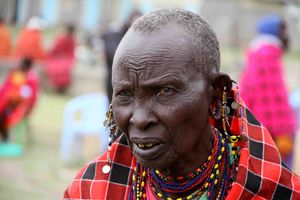Kenya, Uganda join hands to eradicate blindness-causing trachoma

Trachoma-infected eyes.Trachoma is a neglected tropical disease.
What you need to know:
- The bacterial infection is listed by the World Health Organization as a leading preventable cause of blindness worldwide.
- It spreads through contact with discharge from the eyes or nose of an infected person. Hands, clothing, towels and insects can all be routes for transmission.
The ministries of health in Kenya and the neighbouring Uganda have launched the second phase of a joint cross-border mass drug administration in efforts to eliminate trachoma.
The bacterial infection is listed by the World Health Organization (WHO) as a leading preventable cause of blindness worldwide.
The cross-border mass drug administration exercise launched on Sunday targets the highly mobile pastoral communities in Kenya's Turkana West and Loima sub-counties as well as Moroto District in Uganda, who have never received any treatment for trachoma, which spreads through contact with discharge from the eyes or nose of an infected person. Hands, clothing, towels and insects can all be routes for transmission.
The drive is being supported by Sightsavers and RTI International.
Turkana County Director of Preventive and Promotive, Dr Bonventure Ameyo, said despite both countries, through support from various organisations, fully embracing SAFE strategy (surgery, antibiotics, face washing and environmental improvements) to reduce the prevalence of one of the 20 Neglected Tropical Diseases globally, mutual collaboration has been the missing link.
"With each country still on the right track to eradicate the highly contagious disease, previous mass drug administration efforts have been taking place at different times. However, some pastoralists have been missing out as they move across the two nations in search of pasture," Dr Ameyo told Healthy Nation.
He explained that herders who had crossed over to Uganda in search of water and pasture easily re-infected those who had remained behind upon coming back home.
Turkana County has made significant strides by reducing trachoma prevalence from 42.3 per cent in 2010 to the current 9 per cent.
County Director for Medical Services, Dr Gilchrist Lokoel, observed that the devolved unit had a trachoma prevalence rate of 42.8 per cent in 2010.
"Through investment on surgery, antibiotics as well as facial cleanliness through partnership with development partners dealing with water, sanitation and hygiene programmes, the current prevalence rate is now nine per cent," Dr Lokoel said.
The official noted that trachoma is still a public health problem and that is why the county government improved capacity to deal with diagnosis and treatment of eye disorders with the recruitment of ophthalmic surgeons and rationalised posting of ophthalmic nurses throughout the region.
Dr Lokoel noted that Lodwar County and Referral Hospital has established a fully-fledged ophthalmic center with capacity to handle all eye care cases on sight and through outreach services.
Turkana West Sub-county has the highest burden of eye care problems due to high population of the host and refugee communities and harsh climatic conditions.
The first cross-border mass drug administration exercise was launched in October last year in Amudat District of Uganda to ensure communities along the common border receive the much-needed treatment in an effort to fully eradicate the disease.
Through support from the Fred Hollows Foundation and funded through the Accelerate programme led by Sightsavers, the National Trachoma Elimination Programme targeted to treat 2,826,638 persons across seven counties of Baringo, Isiolo, Kajiado, Narok, Samburu, Turkana and West Pokot.
In Kenya, Trachoma is endemic in 12 counties with a combined population of approximately eleven million people, according to the ministry of health.
More than 53,200 Kenyans have been blinded by trachoma.





